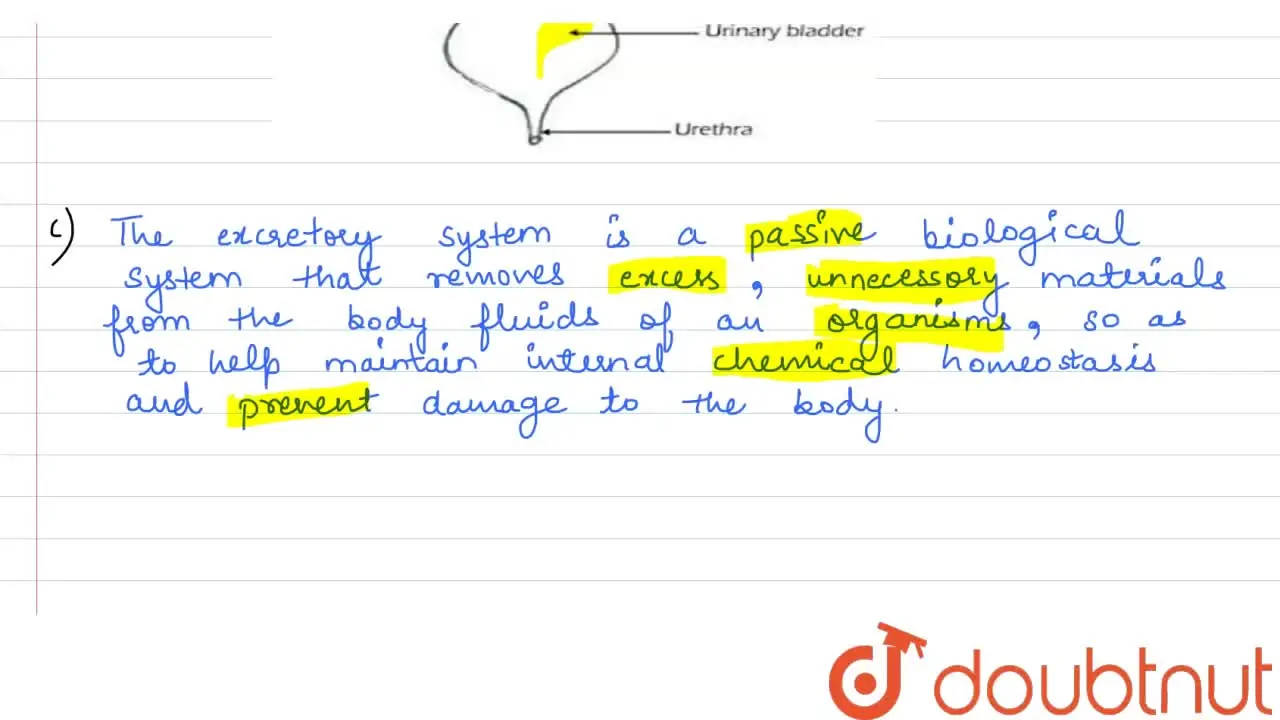(a) Name the various organs of the human excrtory system
(b) Draw a neat labelled diagram of the human excretory system
(c) What is the function of excretory system in humans ?
Human Excretory System
Life of each living being relies upon certain fundamental procedures. Discharge is one among them. Various life forms follow various methods of discharge. In complex creatures including people, there is a specific framework for discharge called human excretory framework.
We as a whole acquire our supplements from various sources which are later processed and utilized in our body. After metabolic responses, the body begins to sift through valuable and dangerous substances in a person. As we as a whole know, the aggregation of the poisons might be hurtful and the body evacuates all the metabolic squanders by the procedure called discharge.
Various life forms follow various methods of discharge, for example, kidney, lungs, skin and eyes relying upon their living space and nourishment propensity.
For instance Aquatic creatures discharge squander as smelling salts, while feathered creatures and creepy crawlies discharge chiefly uric corrosive. People produce urea as the major excretory item.
Excretory System Organs
The human excretory framework organs include:
• A pair of kidneys
• A pair of ureters
• A urinary bladder
• A urethra
Kidneys
Kidneys are bean-molded structures situated on either side of the spine and are ensured by the ribs and muscles of the back. Every human grown-up kidney has a length of 10-12 cm, a width of 5-7 cm and weighs around 120-170g.
The kidneys have an inward sunken structure. At the inside, there is an indent considered hilum through which the veins and nerves enter the organ. Towards the inward surface of the hilum, there is an enormous pipe formed space called renal pelvis with projections called calyces.
Structure of Kidney
The structure of the kidney is clarified as below:
Capsule
The external layer is known as the capsule. Inside the kidney, there are two zones-the external zone is cortex and the internal zone is medulla. The cortex reaches out in the middle of the medullary pyramids as renal sections called segments of Bertin.
Nephrons
Nephrons are the practical units of the kidney. Every nephron has two sections glomerulus and renal tubule. Glomerulus comprises of a lot of vessels shaped by afferent arterioles. Blood from glomerulus is diverted by efferent arterioles. The renal tubule begins with a cup-like structure called Bowman's container and this encases the glomerulus. The malpighian body comprises of glomerulus and Bowman's container. The exceptionally looped structure in the tubule by the Bowman's container is the proximal tangled tubule.
Henle's loop
The following piece of the tubule is Henle's loop which has a rising and a plummeting appendage. The climbing circle proceeds as a distal tangled tubule. The distal tangled tubules of numerous nephrons open into the gathering pipe. The cortical locale of the kidney includes malpighian corpuscle, proximal tangled tubule and distal tangled tubule and the medullary area contains a circle of Henle. There are two sorts of nephrons – cortical and juxtamedullary. On account of cortical, the circle of Henle is short and expands just a little into the medulla. In juxtamedullary, the circle of Henle is long and runs profound into the medulla.
Ureter
A dainty strong cylinder got the ureter leaves every kidney reaching out from the renal pelvis. It conveys urine from the kidney to the urinary bladder.
Urinary Bladder
It is a sac-like structure that stores urine until micturition. Micturition is the removal of urine from the body. The urine is brought to the bladder through the ureters.
Urethra
This cylinder emerges from the urinary bladder and removes urine out of the body. In guys, it goes about as the basic course for sperms and urine. Its opening is watched by a sphincter.
Human Excretory System Diagram
The diagram below represents the different parts of the human excretory system.

Excretion in Humans
Excretion is where all the metabolic squanders are expelled from the body. Excretion in humans is brought through various parts and in a progression of procedures.
The majority of the unicellular life forms dispose of waste from their body through dissemination. A human body is an uncommon machine, where diverse life-forms (breath, course, absorption, and so forth.) happen at the same time. Accordingly, many waste items delivered in our body are in different structures that incorporate carbon dioxide, water, and nitrogenous items like urea, smelling salts, and uric corrosive.
Notwithstanding these, the synthetic substances and other harmful mixes from prescriptions and hormonal items are additionally delivered. A straightforward dispersion or vanishing won't be adequate to kill the loss from our body. Along these lines it is wiped out through various parts in a progression of procedures.
Blood contains both valuable and destructive substances. Henceforth, we have kidneys which separate helpful substances by reabsorption and poisonous substances by delivering urine.
Kidney has an auxiliary filtration unit called nephron where the blood is sifted. Every kidney contains a million nephrons.
Vessels of kidneys channel the blood and the fundamental substances like glucose, amino acids, salts, and the necessary measure of water are reabsorbed. In the mean time, the pureblood flows back to different parts.
Overabundance water and nitrogenous waste in people are changed over to urine. Urine hence delivered is passed to the urinary bladder by means of the ureters. The urinary bladder is heavily influenced by the Central Nervous System. The cerebrum flags the urinary bladder to contract and through the urinary opening called urethra, we discharge the urine.
Mechanism of Excretion in Humans
The process of excretion in humans takes place in the following steps:
Urine Formation
The urine is formed in the nephrons and includes the accompanying advances:
- Glomerular Filtration
- Tubular Reabsorption
- Secretion
Glomerular Filtration
It is the essential advance in urine development. In this procedure, the overabundance liquid and waste items from the kidney are sifted through of the blood into the urine assortment tubules of the kidney and dispensed with out of the body. The measure of filtrate created by the kidneys consistently is known as Glomerular Filtration Rate.
Tubular Reabsorption
It is the ingestion of particles and atoms, for example, sodium particles, glucose, amino acids, water and so forth. Water includes detached ingestion, while glucose and sodium particles are consumed by a functioning procedure.
Secretion
Potassium particles, hydrogen particles, and alkali are emitted out to keep up the balance between the body liquids.
The elements of the different tubules associated with the procedure are:
- Glomerulus channels the blood
- Proximal Convoluted Tubules reabsorb particles, water, and supplements, evacuates poisons, and keeps up the pH of the filtrate.
- Descending Loop of Henle enables water to go from the filtrate into the interstitial liquid through aquaporins.
- Ascending Loop of Henle reabsorbs sodium and chloride particles from the filtrate into the interstitial liquid.
- Distal Tubule reabsorbs and secretes particular particles and keeps up the pH of the blood.
- Collecting Duct, solutes, and water is reabsorbed from the filtrate by the gathering pipe.

Related Playlists
- BOOK - LAKHMIR SINGH & MANJIT KAURCHAPTER - LIFE PROCESSESEXERCISE - very short answer type question1videos
LIFE PROCESSES
- BOOK - LAKHMIR SINGH & MANJIT KAURCHAPTER - LIFE PROCESSESEXERCISE - short answer type question3videos
LIFE PROCESSES
- BOOK - LAKHMIR SINGH & MANJIT KAURCHAPTER - LIFE PROCESSESEXERCISE - question based on high order thinking skills1videos
LIFE PROCESSES
- BOOK - LAKHMIR SINGH & MANJIT KAURCHAPTER - HOW DO ORGANISMS REPRODUCE EXERCISE - QUESTIONS BASED ON HIGH ORDER THINKING SKILLS (HOTS)27videos
HOW DO ORGANISMS REPRODUCE
- BOOK - LAKHMIR SINGH & MANJIT KAURCHAPTER - MANAGEMENT OF NATURAL RESOURCES EXERCISE - VALUE BASED QUESTIONS25videos
MANAGEMENT OF NATURAL RESOURCES
Similar Questions
Excretory system of humans
View SolutionDraw a neat and labelled diagram of human sperm
View SolutionDraw a neat and well labelled diagram of human excretory system.
View SolutionDraw a neat and labelled diagram of a human sperm.
View SolutionDraw and label the parts of the human excretory system.
View SolutionDraw and label the parts of the human excretory system.
View SolutionWith a well labelled diagram , describe human excretory system.
View SolutionDraw a labelled diagram of a human male reproductive system.
View SolutionDraw a labelled diagram of a human male reproductive system.
View SolutionDraw a labeled diagram of sperm.
View Solution


